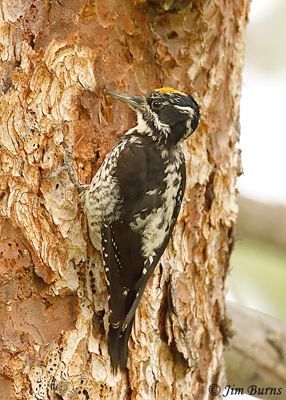
Well, guess what? Last month I got lucky twice. Except I’d rather think of it as perseverance. I’ve always been a grinder, and on two occasions this past August I collected on all the dues I’ve paid to the birding gods over the years. Believe it or not, on both occasions I was given a third chance even after squandering a second.
On a beautiful, clear mountain morning I was hiking a trail in the Baldy Wilderness with the thought of photographing a group of Clark’s Nutcrackers recently posted on one of the websites. I found them alright, but they were in the very tops of some dead snags so high I didn’t even bother to raise the camera. As I pondered my next move, I heard tapping from a nearby Ponderosa Pine. Certainly a woodpecker, and it sounded low, but despite circling the huge tree and glassing for five minutes I could not find the bird.
Disgruntled, and momentarily forgoing my reputation as a grinder, I started back down the trail. Very shortly I encountered a lady resting under a tree studying the back of her camera attached to a telephoto lens. She was smiling from ear to ear, asked if I was an experienced birder, and would I corroborate the identity of the bird she had just photographed. She said she thought it might be her 399th state bird for Arizona, and turned the camera so I could see the LCD screen.
I took a quick look and literally smacked my forehead right there in front of her. American Three-toed Woodpecker, male, and she had a great, close shot. I had not even seen, let alone photographed, a Three-toed since I went digital back in the waning days of slide film, and I immediately realized she had seen the drummer I had not been able to find in that huge Ponderosa.
Sure enough, she walked me back up the trail to the aforementioned Ponderosa, regaling me with how low the woodpecker had been—eye level she claimed, and she had heard it clear back where we topped the little rise thirty yards down trail. Of course it wasn’t there now. We glassed the tree, bottom to top, for five minutes to no avail, then finally heard the distinctive Three-toed tapping farther up trail. We eventually saw it in the same burned out snags where I’d seen the nutcrackers minutes before, but even higher. I didn’t even raise the camera. Then it flew and disappeared over the ridge paralleling the trail. And in this steep terrain there was certainly no chasing it.
No second chances. Muttering to myself, I started back down the trail, again pondering the next move of my trip. I realized not only had I missed on two chances for a bird I really wanted, but if I had done my homework I would have recognized the characteristic cadence and soft volume of the Three-toed’s drumming when I had first heard it. That alone would have prompted me to spend all morning looking for it rather than five short minutes. Woodpeckers are, after all, one of my three favorite bird families (owls and grouse), and Three-toeds, flake specialists, are not common or easily found in Arizona despite our many years of widespread wildfires. It would probably be years before I got another chance.
Halfway back to the trailhead, still kicking myself, I got to thinking--always a dangerous thing, my favorite birding companion loves to say. I had left the Valley with no specific plans other than enjoying the cooler temperatures of the White Mountains and no specific targets other than the nutcrackers. I basically had two more days with no particular agenda. What were the chances that . . . ?
Nah. Hard pass. No chance! I could remember nothing in the birding literature or in my personal birding experience that indicated woodpeckers, especially in post breeding season as it now was, would frequent the same area, let along the same tree, several days in a row. I dismissed the idea out of hand. Two miles uphill from a trailhead in a wilderness area of thousands of acres replete with thousands of dead Ponderosa Pines? Not a chance! That bird could be anywhere tomorrow. Literally anywhere.
Still, I couldn’t dismiss the thought from my mind. At least the hike back up there would be good exercise. And beautiful scenery. And a good story, right, successful or not? Funny, but I remembered years before, when a non-birding friend asked me why she encountered the same flock of pigeons in the same place every morning when she drove her kids to school, I had chided her by asking rhetorically if she didn’t shop at the same grocery store every week. By the time I got back to my vehicle, I had resolved to go for it, bird literature, my experience, and the small odds be damned.
The next morning, another beautiful, clear mountain morning, I left half an hour earlier and didn’t tarry to bird along the way. An hour in, topping the little rise thirty yards below the Ponderosa, the Ponderosa, I stopped to listen. Unbelievably, inexplicably, faint but distinctive, I heard him tapping. He was there! Smacking my forehead only figuratively this time, I actually began running with the tripod and telephoto lens over my shoulder.
I found him immediately. Eye level. Flaking away, busy at breakfast. Confiding--the birders’ term for individuals that are especially cooperative. I couldn’t shoot for a moment until I caught my breath and my hands stopped shaking. Grinding can get boring, but occasionally there is a reward. In my next column I’ll regale you with the story, two weeks later, about the bathing Painted Redstart I photographed after blowing my first two great opportunities because, again, not doing my homework and . . . cows!